This guest post authored by Andrey Ulanov.
In the USSR, the issue of choosing the main pistol cartridge was dealt with twice. For the first time, this was done by a commission in the early 1930s. Back then, a number of Soviet and foreign pistols and submachine guns were tested. In addition to other characteristics, lethal force was also tested. Shooting was carried out at bulls and horses.
The following conclusion was made:
CONCLUSION ON THE CARTRIDGE.
Moving on to the question of the cartridge, the commission considers Mauser’s 7.63mm cartridge to be undesirable for the following reasons:
- A large charge with a relatively light bullet, which provides a high initial velocity and great flatness, at the same time significantly increases the recoil of the system in comparison with systems for other cartridges (for example, 9 mm Parabellum cartridge.). The latter circumstance makes it very difficult to design both small pistols within a certain specified weight, and, in particular, the design of small pistols and submachine guns for a single cartridge (also within a specified weight), since with a large recoil, which strongly shakes the entire system during automatic fire, maintaining the aiming line is impossible and accuracy is negligible, which was confirmed when testing domestic submachine guns chambered for 7.63mm Mauser, which will be discussed below.
- In addition, this cartridge presents great difficulties in production, due to the bottle shape, which also complicates the production of the cartridge chamber. On the other hand, the caliber of the bullet makes it possible to use the 3-line (.30 inch) barrels already in service, which simplifies and standardizes production.
When comparing the characteristics of the Mauser cartridge 7.63mm and 9mm Parabellum cartridge. It can be seen that the Mauser cartridge (see Appendix Nos. 8 and 9), having a charge that is 50% more than the charge of the Parabellum cartridge and the bullet that is 48% lighter, gives an initial velocity that is 25% more than the Parabellum cartridge, while having approximately the same punch action as it. At the same time, due to the smaller caliber, its lethality must be considered significantly inferior to the lethality of the 9 mm Parabellum cartridge. Looking through the weapons of foreign armies, it can be seen that in almost all foreign countries the caliber of pistols is 9 mm and higher. At the same time, due to the smaller charge, the recoil of the system under the parabellum cartridge should be considered less for a given weight of the pistol.
Therefore, the commission considers the 9 mm Parabellum cartridge to be more suitable for adoption, especially since no significant alterations to the Tokarev pistol system, replacing the barrel with a large-caliber barrel, according to the designer’s statement, will be required. As to the cartridges Nagant 7.62mm, Parabellum 7.65mm, and Colt 11.43mm, the commission considers them less suitable for adoption.
As can be seen from this document, the Soviet military in 1930 considered the 9×19 cartridge to be the best for themselves. But at that point, production considerations were more important. In 1930, the USSR was just beginning to industrialize. The necessary tools were available for the 7.62 mm caliber. For the 9mm, they would have to be remade. Therefore, the TT pistol and Soviet PPD submachine guns received a 7.62 mm cartridge.
The second time, the question of the pistol cartridge in the USSR was dealt with after the Second World War. The army’s transition to the new cartridge 7.62×39 mm meant that the submachine gun would no longer be the main weapon of the infantry. As well, the Soviet military wanted a more compact, convenient, and reliable pistol.
In 1947, pistol cartridges were tested at the GAU KA shooting range:
- 7.62 mm TT pistol cartridges manufactured in 1945.
- 9-mm Parabellum (model 08) of German production. Brass sleeve, ordinary bullet. The cartridges were manufactured in 1943.
- 9-mm experimental pistol cartridges of the OP-1 batch, developed by NII-44, manufactured in January 1943 (future cartridges for Makarov pistol 9×18 mm)
- 11.43mm American-made pistol cartridges (aka .45 ACP). Steel sleeve, ordinary bullet. The cartridges were manufactured in 1943.
- 7.65-mm Browning (aka .32 ACP) German production “Geco”. Brass sleeve, ordinary bullet.
American readers will be interested to know that when compiling the test methodology, Soviet officers carefully studied the opinions of American specialists. Here is a list of the methodological literature used in the preparation of:
YS Filatov. Abstract on the stopping and lethal effect of bullets.
The American Rifleman, June 1946. “The Army Is Studying German Pistols”
Ibid, S. Hatcher. “Someone else always seems better.”
The American Rifleman September 1946. “Technical consultation”. S. Hatcher “How stopping action is defined.”
Army Ordnance November-December 1945. Melvin M. Johnson “Are American Weapons the Best.”
V.L. Aleksandrov. Technical hydrodynamics. Ed. 1946.
In the USSR, it was decided to carefully study the effect of bullets. Several target options were used. First, they fired at clay slabs of varying moisture content (an analogue of ballistic gelatin). A slice of clay made it possible to study well the behavior of bullets after being hit.
At the second stage, shooting was carried out at fresh bones of animals (calves) covered with a 5 cm layer of clay. A series of tests was performed with bones of various types and thicknesses.
The test report is over 100 pages long, not counting the tables in the appendix. Therefore, I will confine myself to brief conclusions.
The 11.43 mm bullets gave the deepest penetration and destroyed bones well.
7.62 mm bullets gave good penetration, but quickly lost speed inside. On the bone, they acted worse than 11.43mm, except for the cases when the bullet hit the bone in the lateral position. However, it turned out that the 7.62 bullets quickly lost stability and began to snarl, causing a significant amount of damage.
Bullets 9×19 mm were slightly inferior to both.
Bullets 9×18 mm were inferior to the first three. But even here, the gap was not very significant.
7.65 mm proved to be significantly worse than all the others.
As you know, soon, the USSR received Makarov and Stechkin pistols chambered for 9×18 mm. The Makarov pistol is still very common in the Russian police, although the army replaced it with a 9×19 weapon.
I will allow myself to comment on the conclusions of the officers of the training ground with observations from personal experience. As a shooter, I often have to talk with Latvian police officers or employees of private security firms. After 1991, many of them changed the Makarov pistol for various pistols or revolvers (9×19 or .38sp). The Glock 17 became the standard police weapon but after several years, some officers returned to the Makarov pistol or purchased compact models under the .380. Note that in Latvia the use of expansive bullets for self-defense is legally prohibited, only FMJs are allowed. Nevertheless, many believe that for practical use 9×18 mm or .380 is quite sufficient.

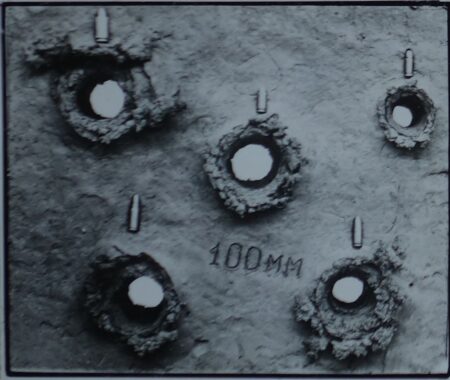
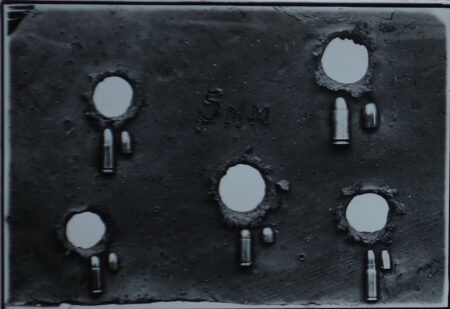
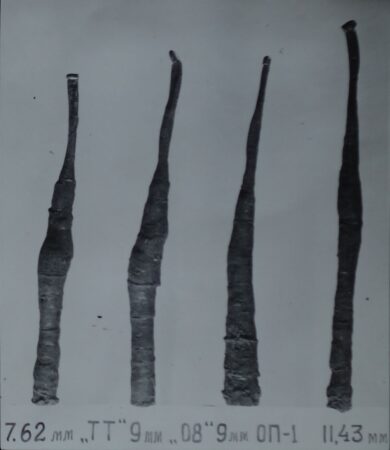
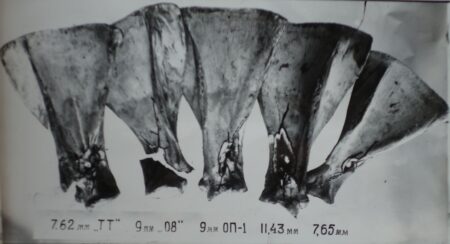
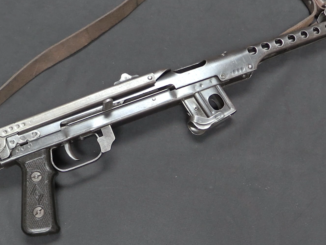
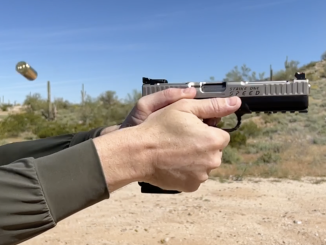
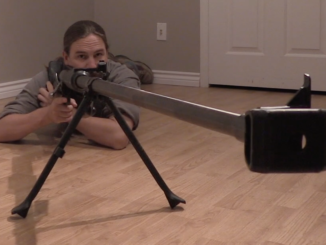
Interesting that they studied American methods but still adopted the Makarov.
It seemed to me the 9×18 would be adequate for most personal defense.
What does the title mean?
“Stopping the action of pistol bullets”
I don’t get it.
I believe it’s an attempt to say stopping power that didn’t survive translation. However the article gets the point across
It’s a translation from Russian – likely “The stopping action of pistol bullets.”
Yeah, that makes sense now. Thanks.
Silly russians.
It’s America Comrade speak Spanish like the rest of us.
Interesting that their first effort based on “common sense” led to the usual bigger must be better conclusion. And that their second effort demonstrated that when you actually shoot things, common sense turns out to be rather imperfect as a decision tool, and that things are in reality either different or much more nuanced.
See also the entire US history of discussion of “stopping power” since about 1960. If not since 1890.
Something almost always missed in comparisons of Soviet vs Western (and especially American) ideas on effectiveness of this or that is what were they trying to be effective at. Often Soviet and Western doctrine was different, and thus the optimal small arms to support that doctrine were different as well. It is not a question of “which is the better arm” but rather which is the appropriate doctrine for that power, and then what arms support that doctrine.
The US HAD adopted a small caliber (.38) round and then found it lacking when up against drug-crazed Moro warriors in the Philippines. If what you are doing is not working, then try something else. So they put .45 caliber revolvers back into service, and kept that diameter when switching to pistols. So the handgun, for them, was a last ditch one-shot stop against a drugged sword-wielding attacker. That probably was not the driving force behind many, if any, other armies in their selection of side arms.
The US also had the luxury of enough mineral and manufacturing resources that the additional lead and copper for .45 as opposed to the 9mm, even when making billions of rounds of ammo, was simply not an issue. In other countries that was not the case, and was a extremely valid point.
I’m not arguing that bigger is better. But the “US had this obsession with bigger-is-better” is a canard. It did not. It had gone from .45 caliber rifles to .30 caliber rifles, and the Navy/Marines had tried going all they way down to 6mm. .30 is smaller than either 8MM Mauser or .303 British. Rifles are orders of magnitude more important than handguns in war, and the US had gone to a smaller caliber for rifles. And it HAD gone to roughly 9mm caliber for revolvers, and when that had poor results, it tried something else. Once adopted, it is hard to change if not given a big reason to do so. That something else was what was in inventory when WWI broke, and then post-war there was little military spending and lots of arms and ammo left over. The submachine gun the US Army ended up with at the start of WWII was what a private company (Thompson) happened to have available–it was not specified and designed on purpose by the military. It was commercial-off-the-shelf (ditto the Marines using them earlier on). Why did it take so long, into the 1980’s, for the US to switch to 9mm, decades after not being up against drug-crazed berserkers? Because no new pistols had been made since the 1940s.
Hence my reference to post-1960, which I mostly meant about the gun writers and commentators. I got tired in the 80s of reading 9 vs 45 articles, mostly written by 45 fans, or pieces on why full-house 357 was the best choice for under-trained cops.
US mil had decided from the 1940s that its next pistol would almost certainly be a 9mm, probably selective DA, and definitely a bit smaller and lighter than the 1911. But it wasn’t a priority until the 80s, by which time the 1911A1s in service were both nearly worn out, and twice as old as the soldiers they were issued to.
None of which is to denigrate the 45 or the 1911. It’s just that neither is as obviously the perfect choice as their fans, some of them very influential, used to make out.
The .38 Colt might have performed better in the Phillipines had it been loaded similarly to the British .38/200. I’m not sure the colt DA as constructed would have taken the pressure,however.
The US adopted the WEAKEST 9mm / .38 cartridge EVER adopted by ANY army.
To take that as an example of the stopping power of 9m cartridges is like taking the .32 ACP as an example of the stopping power of the .308 Win cartridge.
.38 LC was about the same or slightly more powerful than the 9mm Japanese revolver, though, depending on which muzzle velocity for the 9mm Japanese revolver is correct. I have seen 490 fps, 640 fps and 750 fps… Take your pick. 750 fps would admittedly put the 9mm Japanese slightly ahead of the .38 LC black powder military loading.
No one is comparing the .38 revolver in question to 9mm. The point was that it was odd behavior for an allegedly “bigger is better” obsessed military to have adopted the .38 in the fist place.
US Army probably was not “obsessed” with “bigger is better”, but the reaction to the supposed inadequacy of the .38 LC is still telling: instead of seeking a more powerful .38 cartridge (say, something like the .38 Special, which would have been available during and after the Moro rebellion), the reaction was to go back to .45 caliber. In contrast, for example Austria-Hungary and France adopted a more powerful cartridge in roughly the same caliber as their somewhat weak 8mm revolver cartridges (The 8mm Roth-Steyr and 7.65mm Long, respectively. Yes, I know the Austro-Hungarians eventually adopted the 9mm Steyr alongside the 8mm Roth-Steyr. Even that is a much smaller increase than going from .38 back to .45, though).
I am not saying that it was necessarily a wrong decision to switch back to .45 caliber, but I think it shows some preference for larger handgun calibers, even if “obsession” is too strong a word.
I’m not sure that “obsession” is too strong a word in this instance?
The “obsession”, as already said, is shown by the reaction to the supposed inadequacy of the .38LC, along with the “So the handgun, for them, was a last ditch one-shot stop against a drugged sword-wielding attacker. That probably was not the driving force behind many, if any, other armies in their selection of side arms.” Attitude. Like the little colonial adventure the US had in the Philippines was anything different from the colonial adventures of the European states, and the Moro were some sort of super-duper-bullet-resistant fighters anything different from the various natives the European states were facing at the same time with their “puny” 7.62mm to 9mm calibers.
Yes, they thought they found the .38 revolver bullets not working. But did they actually perform autopsies on dead moro warriors? Considering the barely existing budget for anything in the US Army before WW1, the shooters did not receive much training and quite probably did not hit their targets. As we know today a lead bullet from a .38 revolver is quite wounding indeed.
This is a point I keep coming back around to, whenever this issue comes up: The data is really nonexistent, because there’s nothing actually quantified. It’s all subjective impressions of the participants. Did someone miss a shot? Is the guy you’re shooting at really that motivated and hard to kill?
We have much better data on police shootings. Sometimes. And, even then, there’s enough room for debate and discussion as to how effective a given caliber or load in that caliber really is.
It’s my heartfelt belief, extrapolating what I observed of things at the vehicle level in training at the NTC here in the US, that most of what we think we know about combat down at the lowest levels is utter and complete bullshit. It’s way too easy to fall prey to “magical thinking” about what’s going on in the middle of a damn firefight, and you really don’t know much past “Yeah, that guy over there? He quit shooting at me, so I must have been hitting him…”. The reality can be quite different.
In Iraq during OIF, I was sitting in the 101st Airborne’s divisional headquarters watching the “God’s Eye” view of an action through the good offices of a drone camera. There was an enemy element engaging a US unit, and you could see just about everything. The US unit thought that it was taking fire from a location, and returned fire there, calling in aviation support and everything else it had. However, comma… The actual source of the fire they were getting was masked from them, and they were basically blasting an empty hillside. You could watch all this happen because the drone had thermals, and you could see the whole thing taking place in real time. Due to communications issues, nothing we could see could be reported to the guys on the ground. However, no harm was done to the war effort, because someone from a third location absolutely deluged the area where the enemy was shooting from with machinegun fire, and eliminated that threat on our troops. So far as anyone could tell, it looked like it was their own guys, due to the color of the tracer. So, basically, what happened was that we took fire, returned fire at the wrong location, and then the enemy friendly-fired their own guys. The officer on the scene is probably convinced, to this day, that he won that engagement with his brilliant fire direction…
After two years at the NTC watching that same thing happen in training with tanks, I’m totally unsurprised that that happened in actual combat. We don’t even know what we don’t know about a lot of this crap, and we’ve built up most of our tactical and weapons design decisions on some decidedly sketchy information. NGSW is a perfect example of what comes from this–There’s this nebulous “overmatch” idea out there, and none of the people coming up with this BS can even begin to quantify just what that is, whether we really need it, or how much of it we do need if we do… All they know is based on purely subjective impressions gathered by some of the most delusional data-gathering equipment out there, the human being.
Thank you for that!!
Just shows how hard it is to design a cartridge to serve the needs of officers belt jewelry “gun, I have a gun?”, tank crewman “holy crap there’s a lot of them and the tank is busted”, MPs “another 8 hours of shaking door knobs”, infantry “let me drop this baseplate so I can shoot you”, and pilots “can we lose another gram please, my ribs still hurt from that last high G turn”. Like Ian says, compromise.
Every generation, a serious military will try to square that circle by adopting a single weapon and cartridge, think they’ve done it, and then watch it erode as component parts not unreasonably special plead or place small orders for their special requirements.
You end up with things like the VZ61, PM63, or H&K MP7. None of which are particularly brilliant at anything, but aren’t awful at anything else.
If you can accept the limitations of a pure pistol format, something like a Glock 19 is about the least bad choice. But the limitations are significant . I’d be tempted to argue they aren’t that significant if you teach people right (which could be modified Fairbairn techniques for the majority), but that’s a minority sport and an elitist opinion.
General principle: the more you try to have one thing, or variants of it, do a lot of different stuff, the less useful the thing is at any of them.
However, it’s also odd to have an 8-person section/squad including two calibres, three different weapons, and three different feed systems. Though that has been pretty common since 1940, so maybe it’s the right answer.
While reading in Russian sources, I made an observation that they had in past and have to this day great respect to Western and specifically German and American designs and took them often as a reference. If there was an exception to that it was the M16 rifle, but NOT the 5.56mm M193 round which aided them to create their own equivalent.
“(…)NOT the 5.56mm M193 round(…)”
Special cartridge M193-ballistic-wise like but was used during research.
According to https://www.thefirearmblog.com/blog/2016/01/10/5-45×39-small-but-perfect-a-history-of-development/
To conduct ballistics evaluations of a new American round (due to lack of any quantities of actual experimental 5.56 ammo) a ‘hybrid’ was created. It was based on 7.62×39 case necked-down to accept the American-type 5.6 caliber bullets. Bullets themselves were painstakingly re-created using American manufacturing methods. Experimental barrels were also made to replicate twist rate that of an American AR-15.
To their credit they created a shot (in form of 5.45×39) which is not only more effective, but also outlasted the original M193. Just look at numerous iterations of the mentioned American round and see it still does not fully satisfy what was intended (true, the barrel length was dropped from 19 to 14 inches which took toll on terminal ballistics).
Hence new direction to 6.5 – 6.8 caliber projectiles as we witness these days. In the meantime, Russians do nothing and sit on what they have, in fact they recycled old-good 7.62×39 and use it in parallel with the new one. It seems to work for them fine.
There’s a lot of wisdom distilled in Soviet practices across a lot of fields, and in order for you to really understand it, you have to immerse yourself in their mindset about whatever it is you’re looking at. It’s not all “Hurr, durr… The Commies are stupid…”.
And, in some respects, the Soviets were just as nutty about some things as we have been. It’s not all “common sense” and superior in every way–But, an awful lot of it is “fit for purpose”, and all you need to do is figure out what the hell they thought “purpose” was.
Same with a lot of the German stuff–You look at it, and from the outside, you’re like “Uh… What the hell?”, but once you wrap your head around the actual intent, it all comes together.
I would lay down a challenge to anyone looking at unfamiliar tech of any nature–Try to figure out what the hell the original designers were going for, and how their users interpreted that. Once you’ve got your head wrapped around that, then maybe you’ll understand it a lot better. Not everyone looks at the same problem the same way, or tries to solve it that same way, either.
Unfortunately, arms development around here seems to be “worship political cronies or else”, where everyone listens to the guy with the giant wallet and a virtual hotline to Congress (or the President) but not to the guys who did actual testing and fielding.
Ulanov…..Ulanov……Ulyanov….
Why does that name ring a bell?
When you use a pistol for putting a bullet through the heads of dissidents, possible traitors and other enemies of the state, do you really need great penetration?
Funny remark. You do recall they blunted and then drove back the same German army that gave the British and French fits? 5.1 million Germans KIA
“…You do recall they blunted and then drove back the same German army that gave the British and French fits?..”(С)
Having a resource base of an almost inexhaustible number of slaves, protecting the flanks and rear of the allies and providing all the power of the American military industry, this turned out (not that easy) quite doable.
Hitler was defeated not by the USA or the USSR, he was literally trampled by the whole world, and then many times the situation was very ambiguous.
It is a pity that the United States and GB did not have enough eggs to deal with the last fascist regime back in 1945, while there was still such an opportunity…
I’ve said it before, and I’ll say it again: The fact that the Germans got as far as they did had very little to do with the superiority of the Germans during the period 1939-41, and a hell of a lot more to do with the abject inferiority and incompetence of their enemies on the Allied side.
We the people should have held tribunals after the war, placing on trial all the Allied “leaders” right alongside the Nazis/Imperialists, and then hung the lot of them for general incompetence and malfeasance. Hitler would never have gotten as far as he did absent the aid and support he got from Stalin; what happened to the Soviet Union under his leadership from ’41 on was pure karma come back to them on a national scale. Stalin enabled the Western campaigns; in turn, the Soviet people paid for his games.
None of those idiots deserve the least amount of our respect.
I submit to you that all was well coordinated; no errors, no malfeasance to talk about.
The Grand Master of WW2, Right Honorable PM W. Churchill was in USSR during the war FOUR times starting in 1942 right after Stalingrad.
https://en.wikipedia.org/wiki/Moscow_Conference_(1942)
The mentioned guy started the whole thing and ended it on his own terms; no conspiracy theories are required. He tasked Stalin and Josip did as he was asked with some minor deviations. At the end the Soviets went at times little too far and almost entered Denmark. They were stopped by Canadian unit; it was rather tense for couple of days and almost looked like WW2 ver.2 You can say that any pre-arranged play needs some minor adjustments and you will be right.
Why it did not happen and gen. Patton was eliminated? Because there would not be enormously profitable Cold war.
@Denny
General Patton may have been a war hero, but he didn’t have enough political power to need elimination, even if his opinions were unpopular. Also, there is no real evidence to suggest that the car accident that lead to Patton’s death was anything else than just that — an accident. Accidents do happen in the real world all the time and famous people are not immune to them.
Euroman,
the Patton’s story is NOT the central here and I know he was not popular with his bosses – managers of war. It is role of W. Churchill which was absolutely central in execution of war. In every play you have main and side-actors.
One thing due to mention however is that just a week after successful landing in Normandy, the Americans promptly organized the Breton Woods conference. Since then the US dollar became the reserve currency not only for the Europe, but entire world. Thus again, notion of “malfeasance” does not correspond with reality; they (generals and politicians) played their roles extremely well. At the end Americans (state/banks/corporations) were those who gained the most.
https://en.wikipedia.org/wiki/Bretton_Woods_system
Keep in mind Stalin accepted the Germano-Sovietic pact only after several attempt to reach a defense agreement with UK & French governments (who rejected several time his offer).
The same UK & French government who agreed/let the Nazi Germany take control of Czech republic and let Poland (who previously had close cooperation with German army with plans to invade East) be invaded despite the alliance. (Shipments of weapons & tank deliveries were “magically” delayed with cargo waiting at anchorage for few weeks instead of giving the paid goods directly).
Plus other elements, but it would be too long to details all politics involved under, like foreign financing of European fascist parties, etc..
You mean Francoite Spain, which was LITERALLY fascist, and was admitted into NATO?
Some Thirty Years in Law Enforcement including in the military. Many agencies which used the .40 caliber as the new wonder round have gone back to the 9MM. They found out hits where it counts matters the most, and 9MM fills that bill for people not highly experienced with pistol marksmanship. The 7.62 was devastating in Submachine Guns during close-in assaults the Russians liked to counter German long-range automatic fire early in the war. Newly designed bullets which yaw and up set can do similar damage as a HV Hollowpoint.
The U.S. had the pseudo-scientific LaGarde + Thompson “stopping power” tests on hapless cattle in the Chicago stock yards and measuring body parts and corpses moving from bullet impacts…
By the 1920s, there were the so-called “Pig Board” tests, shooting swine with rifle bullets. The 6.5mm rifle bullet had impressive terminal ballistics at the most commonly-encountered combat ranges established by WWI, yet the 7mm was selected as the “compromise” between the smaller caliber and the full thirty 7.62mm. Hence the development of the 7x51mm or .276 Pedersen cartridge, which was quashed by the brass in the army, including Douglas MacArthur in favor of the .30-06 that had been adopted in 1903-1906. At the end of WWII, the 7mm Pedersen was wholly and entirely forgotten, and famously the U.S. insisted on a “new” 7.62x51mm caliber over funny foreign ideas based on some dang’ol defeated German 7.92x33mm kurzpatrone improved sub-machine gun cartridge…. “Whatever.” The Brits cooked up some namby-pamby tea-sipping 7mm cartridge of their own that was similarly slapped down. (sarcasm).
So the Soviets had their own “pig board” but shot horses and steers instead…Interesting.